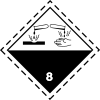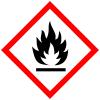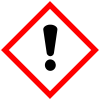HAZMAT Class 8 Corrosive substances
A corrosive material is a liquid or solid that causes full thickness destruction of human skin at the site of contact within a specified period of time. A liquid that has a severe
corrosive material
.
Divisions

454 kg (1001 lbs) or more
hazardous materials
load and segregation chart does not make any reference to the separation of various incompatible corrosive materials from each other. In spite of this, however, when shipping corrosives, care should be taken to ensure that incompatible corrosive materials can not become mixed, as many corrosives react very violently if mixed. If responding to a transportation incident involving corrosive materials (especially a mixture of corrosives), caution should be exercised.
Placards
|
Compatibility Table
| Load and Segregation Chart | |||||||||||||||||||||
|---|---|---|---|---|---|---|---|---|---|---|---|---|---|---|---|---|---|---|---|---|---|
| Weight | 1.1 | 1.2 | 1.3 | 1.4 | 1.5 | 1.6 | 2.1 | 2.2 | 2.2 | 2.3 | 3 | 4.1 | 4.2 | 4.3 | 5.1 | 5.2 | 6.1 | 7 | 8 | ||
| A | B | A | |||||||||||||||||||
| 8 | 1,001 lb (454 kg) | O | O | O | O | O | O | ||||||||||||||
| Key | |||||||||||||||||||||
The absence of any hazard class or division or a blank space in the table indicates that no restrictions apply.
| |||||||||||||||||||||
Packing Groups
| Class 8 Packing Groups | |
|---|---|
| The packing group of Class 8 material is indicated in Column 5 of the 49CFR 172.101 Table. When the 49CFR 172.101 Table provides more than one packing group for a Class 8 material, the packing group must be determined using data obtained from tests conducted in accordance with the 1992 OECD Guideline for Testing of Chemicals, Number 404 "Acute Dermal Irritation/Corrosion" as follows: | |
| Group | Explanation |
| I | Materials that cause full thickness destruction of intact skin tissue within an observation period of up to 60 minutes starting after the exposure time of three minutes or less. |
| II | Materials other than those meeting Packing Group I criteria that cause full thickness destruction of intact skin tissue within an observation period of up to 14 days starting after the exposure time of more than three minutes but not more than 60 minutes. |
| III | Materials, other than those meeting Packing Group I or II criteria:
|
References
- ^ Pipeline and Hazardous Materials Safety Administration (PHMSA) (October 1, 2011). "49 CFR 177.848 - Segregation of hazardous materials" (PDF). Government Publishing Office. p. 853. Archived from the original (PDF) on 16 July 2019. Retrieved 16 July 2019.
- 49 CFR 173.136




